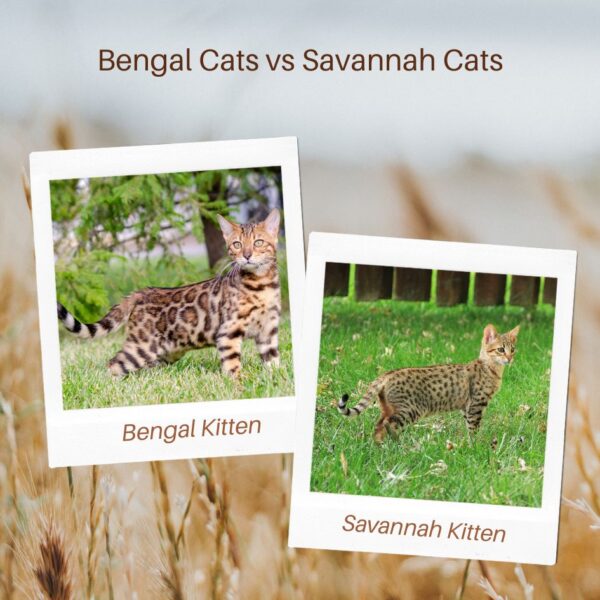
Bengal vs Savannah Cats: Comparing Traits
Bengal cats vs Savannah cats. These two exotic breeds have captivated the interest of feline enthusiasts around the world. Both breeds are renowned for their striking wild appearance and dynamic personalities, traits inherited from their wild ancestors. Bengal cats originate from a cross between domestic cats and the Asian leopard cat, giving them a spectacular spotted or marbled coat resembling that of a jungle leopard. On the other hand, Savannah cats are a cross between a domestic cat and the larger serval cat from Africa, which bestows upon them a tall, slender build and a similarly wild-looking coat.
The breeding of these cats has stirred both fascination and controversy, particularly regarding the ethics of creating hybrid breeds that carry wild genetics. Genetic considerations play a crucial role in the development and maintenance of Bengal and Savannah breeds, both of which can exhibit a range of colors and patterns. These genetic factors have also introduced unique health and personality traits that potential owners need to consider. Despite their similarities, Bengals and Savannahs differ greatly in size, behavior, and care requirements, encapsulating a broad spectrum of what it means to live with a cat that echoes the essence of their wild relatives.
Key Takeaways
- Bengal and Savannah cats are hybrids with distinctive wild appearances and active dispositions, but with varied physical traits and care needs.
- Ethical considerations, along with health and personality characteristics, are vital to understand for prospective owners of these exotic breeds.
- Legal regulations, costs of ownership, and compatibility with human lifestyles should be contemplated when considering a Bengal or Savannah cat.
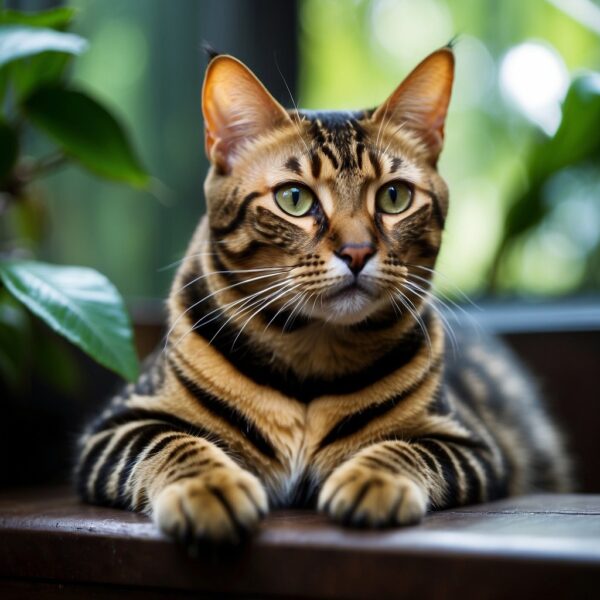
Bengal vs Savannah cats: Origin and History
The development of exotic domestic breeds like the Bengal and Savannah cats stems from the crossbreeding of wild and domestic species. These breeds stand out for their unique appearances and lineages that connect them to the wild.
Origins of Bengal Cats
Bengal cats trace their origins back to the 1970s when Jean Mill crossed an Asian Leopard Cat, a small wild cat native to Southeast Asia, with domestic felines. This intentional crossbreeding aimed to replicate the distinctive coat patterns and sturdy build of the wild ancestor while maintaining the temperament of domestic cats. Most commonly, domestic breeds like the Egyptian Mau were used due to their similar coat patterns. Bengals are thus recognized for their striking appearance that includes large spots, rosettes, and a structure reminiscent of their wild counterparts.
Origins of Savannah Cats
The origins of the Savannah cat are more recent, with the first known birth occurring in 1986. A cross between a wild Serval and a domestic cat led to this new breed. Servals, African medium-sized large-eared wild cats, provided the Savannah with its remarkable height and large ears. The domestic cats used in the breeding process, similar to Bengals, often come from breeds like the Egyptian Mau to preserve particular aesthetic traits. As a result, Savannah cats exhibit a tall, lean physique and coat patterns that echo the wild side of their lineage.
Both the Bengal and Savannah breeds have unique spots and stripes inherited from their wild ancestors, Asian Leopard Cat and Serval, respectively, blended with the temperament of typical domesticated cats, making them desirable pets for those looking for an exotic feline presence in their home.
Bengal vs Savannah Cats: Breed Development
In exploring the intricate world of domestic feline breeds, particularly the Bengal and Savannah cats, it is crucial to understand the genetic nuances and intentional development that distinguish these breeds.
Bengal Genetics
The Bengal cat is a hybrid breed that originated from the crossbreeding of domestic cats with the Asian Leopard Cat (Prionailurus bengalensis). This initial crossbreeding was done to capture the exotic appearance of the Asian Leopard Cat while maintaining the temperament of a domestic cat. As a result, Bengal cats exhibit a distinct coat pattern that can include spots, rosettes, or a marbled look. Such traits are believed to be influenced by the Agouti (ASIP) allele inherited from the Asian Leopard Cat. The first filial generation of these hybrids, known as F1 Bengals, has one Asian Leopard Cat parent and one domestic cat parent. Over time, breeders have worked to preserve and enhance these characteristics while adhering to The International Cat Association (TICA) standards for breed development.
Key Genetic Traits in Bengal Cats:
- Coat Patterns: Spotted, Rosetted, Marbled
- Genetic Influences: Asian Leopard Cat’s ASIP allele
- Hybridization: Occurs in initial breeding (F1 generation)
Savannah Genetics
Savannah cats originated from crossing a domestic cat with a Serval (Leptailurus serval), an African wildcat. This breed is known for its large, tall stature and spotted coat, resembling its wild ancestor. The F1 generation Savannahs have a Serval as one parent, and they are the largest among the breed, with subsequent generations becoming smaller and more domesticated in temperament. Similar to Bengals, the genetic makeup of Savannahs is a blend of wild and domestic traits, meticulously developed under TICA’s breed requirements.
Key Genetic Traits in Savannah Cats:
- Stature: Large and Tall
- Coat: Prominent Spotted Pattern
- Wild Ancestory: Direct Serval linage in F1 generation
- Development: TICA’s breed standards guide breeding practices
Both breeds represent fascinating examples of genetic complexity and the careful engineering of breed characteristics that yield cats with both a wild appearance and compatibility with domestic life.

Bengal vs Savannah Cats: Physical Characteristics
Bengal and Savannah cats are prized for their unique and exotic appearances, which closely resemble their wild ancestors. Both are known for their striking coat patterns and colors, but they exhibit distinct physical traits that set them apart.
Bengal Appearance
Bengal cats have a robust build with a muscular body. They exhibit a striking coat that often features rosettes or spotted patterns, reminiscent of their wild ancestor, the Asian leopard cat. Bengal coats can appear in various hues, including brown-spotted, silver, and marble, all of which contribute to their exotic look.
Savannah Appearance
Savannah cats are known for their tall, lean, and elegant bodies. Their most distinguishing feature is their large, tall ears, which are set high on their heads and contribute to their wild appearance. Savannah’s coat patterns are predominantly spotted, and they too can display a range of colors, such as black, brown spotted, and silver.
Size and Weight Comparisons
- Bengal Cats
- Size: Medium to large
- Weight: Males typically 10-15 lbs, Females slightly smaller
- Savannah Cats
- Size: Medium to large, taller than Bengals
- Weight: Males can be 12-25 lbs, Females lighter
Coat Patterns and Colors
Bengals often have a high degree of contrast in their coats, with clear patterns on a lighter background. They may display rosettes that form a unique pattern or marbled designs that create a swirling effect. Savannahs typically exhibit a more uniform spotted pattern across their bodies. While both can have a wild appearance, the clarity and type of these markings will differ, often influenced by the hybridization of the domestic cat with their respective wild ancestors.
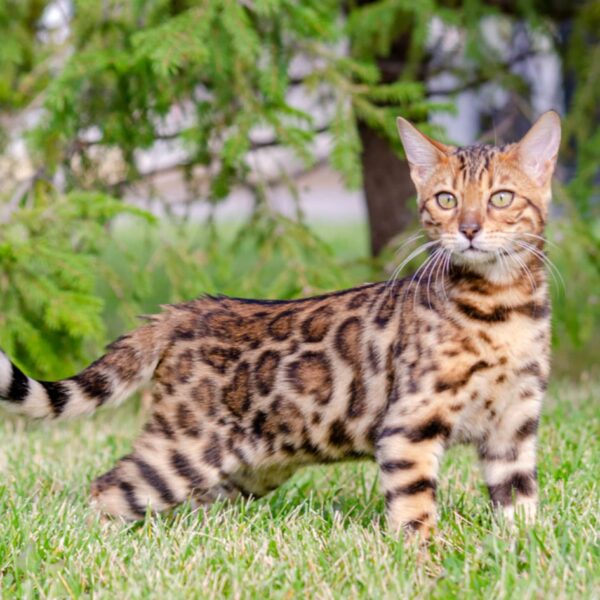
Bengal vs Savannah Cats: Personality and Temperament
Distinct in their personalities, Bengal and Savannah cats are both known for their unique temperaments and engaging characteristics. These breeds are often chosen by those looking for interactive and energetic pet companions.
Bengal Cat Temperament
Bengal cats exhibit a highly energetic and playful personality. They are known to form loyal bonds with their owners, often displaying their affection in active ways. Intelligent and curious, Bengals require stimulation; they are often found engaging in activities that challenge their physical and mental acumen. This breed is highly social and tends to be vocal, with a wide range of chirps and meows used to communicate with their human families.
- Intelligent: Solve puzzles and learn tricks quickly
- Active: Need plenty of exercise
- Affectionate: Form strong bonds with their owners
- Playful: Enjoy interactive games
- Vocal: Communicate with distinctive sounds
Savannah Cat Temperament
Inherited from their wild ancestry, Savannah cats are intensely active and intelligent. They carry a sense of adventure and a playful streak but are also known for being affectionate with their human counterparts. They thrive in environments where they can explore and play. Savannahs can be vocal and enjoy a good conversation with their owners. They exhibit loyalty but can sometimes show it in more independent ways compared to other breeds.
- Energetic: Require spacious environments to roam
- Loving: Seek attention and interaction from their owners
- Social: Good with other pets if properly introduced
- Affectionate: Enjoy being close to their human family
- Intelligent: Can learn to open doors and retrieve objects
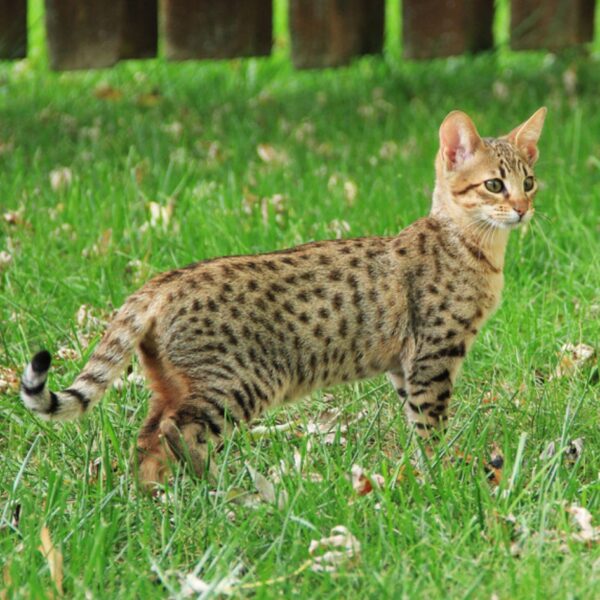
Care and Maintenance
Caring for Bengal and Savannah cats requires an understanding of their specific needs in terms of exercise, grooming, diet, and health to ensure these energetic and intelligent breeds thrive.
Exercise Needs
Bengal and Savannah cats are highly active and require daily exercise for their physical and mental well-being. Playtime is crucial and should include activities that stimulate their hunting instincts.
- Bengal Cats: Require a minimum of 30 minutes of interactive play daily.
- Savannah Cats: Benefit from longer play sessions and outdoor walks, if possible.
Grooming Requirements
Both breeds have short coats that are relatively easy to maintain, but they have different grooming needs.
- Bengal Cats: Their coats need a weekly brushing to remove loose fur and reduce shedding.
- Savannah Cats: They have slightly coarser coats that may require more frequent brushing to stay sleek.
Pay attention to their eyes and ears, which should be checked and cleaned regularly to prevent infections.
Diet and Nutrition
A balanced diet that is rich in protein is vital for these cats due to their energetic nature.
- Bengal Cats: May benefit from high-quality dry kibble supplemented with wet food.
- Savannah Cats: Often require a diet with a higher percentage of wet food or raw diet to mimic their natural dietary habits.
Access to fresh water should always be available to prevent dehydration.
Health Considerations
Both breeds may have specific health issues that owners should monitor.
- Bengal Cats: Prone to heart conditions like hypertrophic cardiomyopathy and some inheritable genetic conditions.
- Savannah Cats: May face health problems due to their hybrid nature. Vigilance for signs of illness is essential.
Regular veterinary check-ups are necessary to identify and address any health problems early. It’s also important to keep vaccinations and preventatives for parasites up to date.
Living with a Bengal or Savannah Cat
Choosing to share your home with a Bengal or Savannah cat is an enriching experience that requires understanding their unique attributes. These domestic breeds are known for high energy levels and intelligence, making them an engaging pet for families and individuals alike.
Domestic Compatibility
Both the Bengal and Savannah cat breeds are family-friendly and known for their loyalty to their human companions. They fit well into homes where they can receive ample attention and interaction. Their intelligence makes them relatively easier to train than some other breeds, but they also require consistent mental stimulation. Providing a variety of toys and play sessions is crucial for keeping these breeds occupied.
- Bengal Cats are playful and curious by nature. They enjoy interactive toys that challenge their intelligence.
- Savannah Cats, being a crossbreed of a domestic cat and an African Serval, inherit a mink-like coat and an athletic build, which contributes to their need for space to roam and play.
Environmental Considerations
Both breeds are known to be athletic and muscular, often exhibiting a high level of energy — a trait to consider when planning your living space.
- Access to Outdoors: If living conditions permit, access to a safe outdoor enclosure can benefit these cats enormously. However, owners should ensure they cannot escape and that the area is secure from predators.
- Indoor Environment: For indoor living, a spacious environment with vertical spaces like cat trees can help them stay active and engaged.
Training and Socialization
Due to their intelligence, both Bengal and Savannah cats respond well to training, which can help mitigate potential undesirable behavior and facilitate their socialization.
- Bengal Cats: They are known for being receptive to training, including leash walking and playing fetch.
- Savannah Cats: Their larger size and more wild ancestry make socialization particularly important. Introducing them to a variety of people and experiences early on is beneficial.
In conclusion, Bengal and Savannah cats are suitable for individuals looking for a pet that is a bit out of the ordinary. Their high energy and need for interaction make them great pets for active families or individuals who have the time to engage with their pets consistently. Socialization and environmental enrichment are key factors to ensure a happy, healthy life for these remarkable and affectionate cats.
Legal and Ethical Considerations
In the world of hybrid cat breeds such as Bengal and Savannah cats, legal and ethical considerations play critical roles. Ownership and breeding practices are subject to regulation to ensure the welfare of the cats and compliance with laws.
Ownership Regulations
Bengal Cats:
- In some regions, ownership of Bengal cats is regulated due to their ancestral lineage with the Asian leopard cat.
- They are generally legal to own, but it’s prudent to consult local legislation, as laws can vary by jurisdiction.
Savannah Cats:
- The legality of owning a Savannah cat can depend on the generation of the hybrid. Earlier generations (F1, F2) that are closer to their wild ancestors, the serval, may face stricter regulations.
- The International Cat Association (TICA) recognizes ownership of Savannah cats, but potential owners should verify local laws.
Breeding Ethics
Ethical Breeding Practices:
- Breeders must prioritize the health and well-being of both hybrid breeds, avoiding inbreeding and ensuring genetic diversity.
- Ethical breeding also entails providing proper care and socialization for kittens before placement.
Breeding Regulations:
- Breeders of Bengal and Savannah cats may need to adhere to specific laws and guidelines, which can include permits or restrictions on breeding certain generations.
- The International Cat Association (TICA) provides standards and ethical guidelines that breeders are encouraged to follow to maintain the integrity of the breeds.
Cost of Ownership
When considering a Bengal or Savannah cat, potential owners should be aware that the financial investment extends far beyond the initial purchase price. They require a long-term financial commitment due to their unique needs and potential health concerns.
Initial Purchase Price
Bengal Cats:
- Price Range: Typically range from $1,500 to $3,000 for pet quality. Show quality or cats from exceptional bloodlines can exceed $5,000.
Savannah Cats:
- Price Range: Usually start around $1,000 but can go as high as $20,000 or more for high F-generational cats, which are closer to their serval ancestors.
Long-Term Financial Commitment
Bengal Cats:
- Healthcare: Routine veterinary care, potential breed-specific issues.
- Maintenance: Costs for diet, toys, and possible damage to the household due to their active nature.
Savannah Cats:
- Healthcare: Regular check-ups, vaccinations, and possible breed-specific health issues.
- Infrastructure: May include higher fences or secure outdoor enclosures due to their strong predatory instincts and desire to climb and explore.
- Maintenance: Similar to Bengals, costs for high-quality diet, enrichment, and larger, more robust play structures.
Comparison and Considerations
When considering a pet, the distinction between Bengal and Savannah cats is key, as both offer unique traits and care requirements that potential owners should be aware of.
Differences Between Bengal and Savannah Cats
Size and Appearance:
- Bengal Cats: Typically weigh 8-15 pounds with a distinctive coat of rich colors and rosette or marbled patterns.
- Savannah Cats: Larger, weighing 12-25 pounds, with taller and leaner bodies and spotted coats resembling their wild ancestors.
Temperament:
- Bengal Cats: Known for their energetic and playful nature, may require plenty of stimulation and interactive play.
- Savannah Cats: They exhibit high energy levels too, often showcasing more dog-like behaviors including loyalty and a tendency to follow their owners.
Lineage:
- Bengal Cats: A hybrid breed from domestic cats and the wild Asian leopard cat.
- Savannah Cats: The result of breeding domestic cats with the serval, a wild African cat.
Regulations:
- Bengals and Savannahs may face varying legislation. It’s crucial to understand local laws regarding ownership, as some regions have stricter rules for hybrid cat breeds.
Similarities Among the Breeds
Hybrid Nature:
- Both Bengals and Savannahs are hybrid breeds, with a mix of wild and domestic feline traits.
Activity Level:
- They share a high demand for physical activity and mental engagement; consequently, they are not ideal for owners seeking low-energy pets.
Grooming Needs:
- Both Bengals and Savannahs possess short coats that are typically low-shedding, thus requiring similar grooming routines.
By understanding these key differences and similarities, owners can make informed decisions aligned with their lifestyle when choosing between a Bengal or Savannah cat.
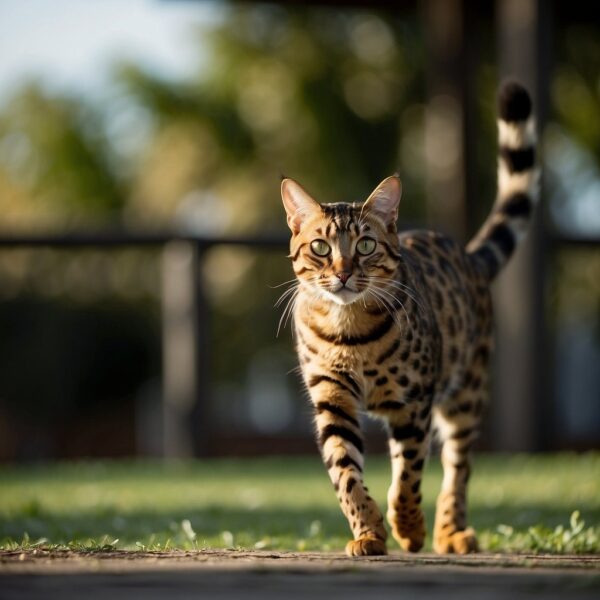
Bengal vs SAvannah Cats Frequently Asked Questions
When comparing Bengal and Savannah cats, prospective owners often have several questions regarding size, cost, cohabitation, behavior, appearance, and genetics-related temperament.
Which is larger, a Bengal cat or a Savannah cat?
The Savannah cat is generally larger than the Bengal cat. Savannahs can weigh between 12 to 25 pounds, while Bengals usually weigh between 8 to 15 pounds.
What is typically the price difference between a Bengal cat and a Savannah cat?
Savannah cats tend to be more expensive than Bengal cats. The price for a Bengal cat typically ranges from $1,000 to $3,000, whereas Savannahs can range from $1,500 to over $20,000, reflective of their exotic lineage and generation number.
Can Bengal and Savannah cats coexist peacefully?
Yes, Bengal and Savannah cats can coexist peacefully with proper introduction and socialization. Both breeds are active and playful, which can lead to forming bonds through shared activities.
What distinguishes the behavior of Bengal cats from that of other cat breeds?
Bengal cats are known for their high energy levels and need for mental stimulation. They stand out due to their love of water, vocal nature, and strong hunting instincts compared to other domestic cat breeds.
Which is more exotic in appearance, the Bengal or the Savannah?
Bengal vs Savannah Cats appearance. Both the Bengal and Savannah have exotic appearances, but Savannahs, with their taller and leaner bodies, large ears, long legs, and spotted coats, are often considered to resemble their wild ancestors, such as the African Serval, more closely.
How does the presence of wild genetics, such as that from the serval, impact the temperament of Savannah cats?
The wild genetics from the serval in Savannah cats contribute to their heightened curiosity, energy levels, and intelligence. Early generation Savannahs may display stronger wild traits, while later generations are more domesticated in temperament.